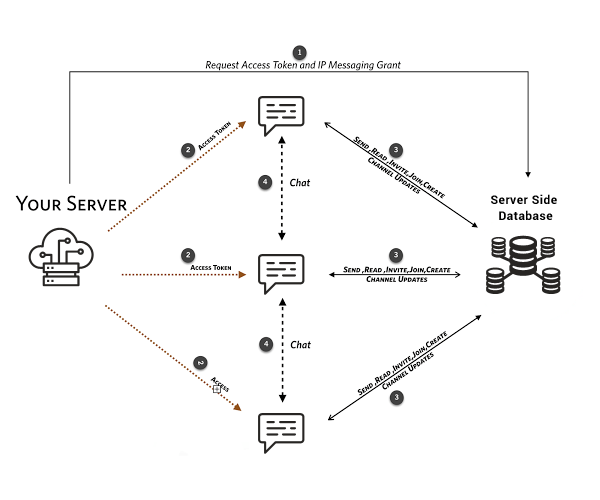How MirrorFly Facilitates Chat Storages at Client and Server Side Database?

You might have heard the word “Slack” where startups and small businesses of the world are dominated. The demand for online communication across the business and workplace brings the entire collaboration in one place. The necessity of a real-time chat server which provides live community interaction relies on different platforms providing group chat or channel based on the number of users.
Most of the web chat providers for collaboration in the market like Slack, Hipchat are built on the server-side database where the messages sent are stored in the server database. This results in the storage of a vast amount of data in the server-side data storage.
On the other hand, the client-side database is the best way to store chat messages in a database since it minimizes data by holding it within the device. This underpinning of development is carried in MirrorFly infrastructure which offers the best chat app database design for storing chat messages for diminishing the queuing of messages and consumption of data.
These server scenario variations occur during the development of web chat applications under concurrent users. To get a more insightful view of these group chat database designs, let us have a brief comparison between Client-side database storage and Server-side database storage in group chat applications.
Comparison On Client-side Database Storage Vs Server-side Database Storage in Group Chat Applications
| Real-Time Chat Server-side Database | Real-Time Chat Client-side Database |
The rendering of web pages, and push notifications are performed at real-time where relaying of minimum messages is carried. | The browser support delivers a massive number of messages at an actual rate. |
| Retrieval of message history within the group chat application is not achievable where the community is an open group. | The access of messages within a group or channel exceeding 500 members is achievable in client-side data storage development. |
| This consumes a huge amount of storage when it comes to withholding concurrent users within the group chat application due to their chat app data model | The rendering of web pages, push notifications are performed at real-time where relaying of minimum messages is carried. |
Chat Functionality on Server Side Database
The data transmission between the client and server is processed with a single token key. Here the server-side scripts run on the server instead of the client-side server in order to deliver the content (message) in response to the action carried in the user device.

Chat Functionality on Client Side Database
The illustration explains the message transmission flow where the servers serve the transmission of data to the client device by accessing the token keys. Further, the client device sends the request to multiple servers to access the message with the client-side token key.

Most of the group chat applications are relying on server protocols such as MUC and Pubsub to achieve a concurrent user base. Both the servers, server-side database, and client-side database storage provide access to the data where the server-side database is partial and client-side database storage access is completely open under a secure environment. Let us discuss the architecture of MUC and Pubsub used in service-to-service communication in group chat applications.
How Multi-user Chat and Pubsub Server Components work in a real-time chat server design
The chat application database schema is arranged in such a way that both the server components offer real time group chat functionality inside a virtual room. MirrorFly ensures participation of concurrent users within the group is clustered with Pub Subcomponents for better interaction and collaboration among the users.
The MUC component enables us to take control of administration and accessibility under a group or community of about 1000+ members. Both the server components, MUC and Pubsub, provide end-users to create N number of chat groups and channels where the group restriction is not a complex one.
When it comes to the security breach on the MUC component, it serves the highest degree of security layer to messages when the user base limit is under 1000+. Once the concurrent users’ range exceeds 10 Lakhs within the group chat room, Pubsub ensures the content within the chat room is secure from unauthorized access.
When the user’s participation ranges more than 1 Lakh, MUC-based chat groups become open and accessible to others. Pubsub makes the content available in the client-server when the users are offline, thus rendering messages to users at a faster rate. This helps in relaying messages instantly to the right group at the right time with the reduction of data consumption. This was made possible by modeling the best database for chat applications.
Conclusion
In every chat database architecture, all the servers are designed in such a way to perform the required process of transmitting and rendering of group chat applications. In this trend of real-time and instant collaboration in business and enterprises, group chat applications along with effective chat database design have its own demand across industries. Most enterprises urge to develop group chat applications on their own on-prem infrastructure to experience a concurrent user base for different business applications.
And MirrorFly backs this by offering a self-hosted chat solution, besides its real-time messaging SDK as a part of its SaaS plans.
We are ready to help you build your effective server database. Contact us for support.
We would like to have more details on the Chat API & SDK. We develop web and mobile applications, would like to have more options to present. Would highly appreciate your quick reply.
Can we use our own sever to manage the video and voice call
Of course, Our Solution is support dedicated hosting server or on-prem infrastructure.
Shall we use a firebase Real-time Database?
Firebase database is essentially a centrally located huge JSON tree, and any changes to any part of it are instantly propagated to all those observing the database.